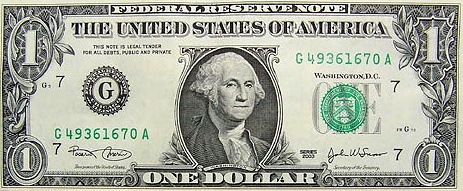|
PROCESS
This process is
taught and used by the old Dutch Masters. It is written and
domonstrated by Russian artist Alexei
L. Antonov. This is very similar to the process I use
today.
 1. Stop looking at modern art and stop loving it. Modern bright colors
and hue contrasts destroy the subtle vision of the painter who risks to
study classical painting in our time.(Not my suggestion-his!)
1. Stop looking at modern art and stop loving it. Modern bright colors
and hue contrasts destroy the subtle vision of the painter who risks to
study classical painting in our time.(Not my suggestion-his!)
 2. Many painters get an energy charge from music. Stop listening to any
modern music and begin listening only to classical music. Try to begin
loving it. (Not my suggestion-His!)
2. Many painters get an energy charge from music. Stop listening to any
modern music and begin listening only to classical music. Try to begin
loving it. (Not my suggestion-His!)
 3. Brushes. You should have many brushes so that not to lose time
washing them while working. Take a new brush for every new mix. Use
round kolinsky brushes, #1 to #10. To cover larger surfaces, you will
need a few #20 to #35 brushes. For final strokes PRIPLAVLENIYE (final
blending) you will need a few very soft round and flat average size
squirrel brushes. Brushes should be treated very carefully. After every
session they should be washed in turpentine and after that in warm water
with soap.
3. Brushes. You should have many brushes so that not to lose time
washing them while working. Take a new brush for every new mix. Use
round kolinsky brushes, #1 to #10. To cover larger surfaces, you will
need a few #20 to #35 brushes. For final strokes PRIPLAVLENIYE (final
blending) you will need a few very soft round and flat average size
squirrel brushes. Brushes should be treated very carefully. After every
session they should be washed in turpentine and after that in warm water
with soap.
 4. The palette must be made of hard dark wood, best of all, of pear.
After work wash the palette with turpentine and scrape it with a razor.
Before work wipe the palette with linseed oil.
4. The palette must be made of hard dark wood, best of all, of pear.
After work wash the palette with turpentine and scrape it with a razor.
Before work wipe the palette with linseed oil.
 5. The canvas should be primed additionally a few more times and in
conclusion it should be ground with fine sandpaper. After that the
canvas should be scraped with a razor to remove the canvas texture till
smooth dead surface similar to the egg's surface is achieved.
5. The canvas should be primed additionally a few more times and in
conclusion it should be ground with fine sandpaper. After that the
canvas should be scraped with a razor to remove the canvas texture till
smooth dead surface similar to the egg's surface is achieved.
 6. It is very important to have objects for still lifes in the studio.
Don't be stingy at garage sales and flea markets, you may regret it
later.
6. It is very important to have objects for still lifes in the studio.
Don't be stingy at garage sales and flea markets, you may regret it
later.
 7. Thedrawing is made on paper life-size to the
smallest details. Then it is transferred to the canvas by carbon-paper.
After that the drawing is outlined
with brown ink because the first oil layer - IMPRIMATURA (transparent
coat that is equal to the middle tone of largest, lightest object in
painting) - will wash away the pencil, but the ink will remain visible
almost through the last layers. (I do not draw on the canvas first.
I always begin my still life paintings with the IMPRIMATURA layer - it
is best for creating initial form in a direct manner.)
7. Thedrawing is made on paper life-size to the
smallest details. Then it is transferred to the canvas by carbon-paper.
After that the drawing is outlined
with brown ink because the first oil layer - IMPRIMATURA (transparent
coat that is equal to the middle tone of largest, lightest object in
painting) - will wash away the pencil, but the ink will remain visible
almost through the last layers. (I do not draw on the canvas first.
I always begin my still life paintings with the IMPRIMATURA layer - it
is best for creating initial form in a direct manner.)
 8. Before each new layer the canvas (ideally dried during 7 weeks) is
carefully wiped with a half of an onion (in order to prepare the dried
surface to absorb better) and then with linseed oil. After that the
canvas is wiped with a soft piece of cloth.(I do not allow 7 weeks and
the onion is definitely out of the question)
8. Before each new layer the canvas (ideally dried during 7 weeks) is
carefully wiped with a half of an onion (in order to prepare the dried
surface to absorb better) and then with linseed oil. After that the
canvas is wiped with a soft piece of cloth.(I do not allow 7 weeks and
the onion is definitely out of the question)
 9. The lacquer for IMPRIMATURA is
made of 2% of dry DAMAR CRYSTALS and 98% of turpentine. The lacquer for
painting is made of 5-10% of dry resin and 90-95 % of turpentine. A
couple of lavender oil drops are added directly to the oil-can.
Scientists say lavender oil stimulates the brain. However, I think that
old masters added it to eliminate the heavy turpentine smell. The
lacquer for the final step consists of 30% of DAMAR CRYSTALS, 3% of
linseed oil, and 67% of turpentine. (My mixing medium is made of the
same combinations of mediums above only different percentages)
9. The lacquer for IMPRIMATURA is
made of 2% of dry DAMAR CRYSTALS and 98% of turpentine. The lacquer for
painting is made of 5-10% of dry resin and 90-95 % of turpentine. A
couple of lavender oil drops are added directly to the oil-can.
Scientists say lavender oil stimulates the brain. However, I think that
old masters added it to eliminate the heavy turpentine smell. The
lacquer for the final step consists of 30% of DAMAR CRYSTALS, 3% of
linseed oil, and 67% of turpentine. (My mixing medium is made of the
same combinations of mediums above only different percentages)
 10. The basic set of paints is the following: "Rembrandt" oil
colors: Flake White, Yellow Ochre Light, Red Ochre, Burnt Umber, Raw
Umber Ivory and Lamp Black (7 Basic Colors), and 4 extra colors (when
necessary) which I use in the last layers: Flake Yellow (instead of it
also can be used Cadmium Yellow Deep), Madder Lake Deep, Chinese
Vermilion, Prussian Blue. But be careful, use these last 4 colors very
sparingly.
10. The basic set of paints is the following: "Rembrandt" oil
colors: Flake White, Yellow Ochre Light, Red Ochre, Burnt Umber, Raw
Umber Ivory and Lamp Black (7 Basic Colors), and 4 extra colors (when
necessary) which I use in the last layers: Flake Yellow (instead of it
also can be used Cadmium Yellow Deep), Madder Lake Deep, Chinese
Vermilion, Prussian Blue. But be careful, use these last 4 colors very
sparingly.
 11. IMPRIMATURA, or the first paint layer. The canvas
is covered with a liquid mixture based on Red Ochre, Yellow Ochre Light
and Ivory Black (the mixture should have an olive hue).
11. IMPRIMATURA, or the first paint layer. The canvas
is covered with a liquid mixture based on Red Ochre, Yellow Ochre Light
and Ivory Black (the mixture should have an olive hue).
 12. The shadow PODMALYOVOK (the
process of creating intermediate layers) is made with Burnt Umber in two
layers (2nd and 3rd layers). In the
second layer all details are made excluding the texture. In the third
layer LESSIROVKA of the main tone masses is made with a big brush.
12. The shadow PODMALYOVOK (the
process of creating intermediate layers) is made with Burnt Umber in two
layers (2nd and 3rd layers). In the
second layer all details are made excluding the texture. In the third
layer LESSIROVKA of the main tone masses is made with a big brush.
 13. The dead layer - the fourth
PODMALYOVOK - is made with white lead, light ocher, red ocher, and burnt
bone. The aim of this PODMALYOVOK is penumbra. The picture must look as
if its objects were lit with moonlight - olive cold gray color. Colors
are applied thickly, half a tone higher, shadows are very transparent,
half a tone lower.
13. The dead layer - the fourth
PODMALYOVOK - is made with white lead, light ocher, red ocher, and burnt
bone. The aim of this PODMALYOVOK is penumbra. The picture must look as
if its objects were lit with moonlight - olive cold gray color. Colors
are applied thickly, half a tone higher, shadows are very transparent,
half a tone lower.
 14. The first and the second
TEL'NII (flesh tones: main life colors) PODMALYOVOK (5th
and 6th layers). The first TEL'NII
PODMALYOVOK is made half a tone lighter and two tones lighter in colors;
and half a tone darker and two tones lighter in shadows. The same is
true of the second TEL'NII (?body?) PODMALYOVOK.
14. The first and the second
TEL'NII (flesh tones: main life colors) PODMALYOVOK (5th
and 6th layers). The first TEL'NII
PODMALYOVOK is made half a tone lighter and two tones lighter in colors;
and half a tone darker and two tones lighter in shadows. The same is
true of the second TEL'NII (?body?) PODMALYOVOK.
 15. LESSIROVKA - the seventh layer:
details of textures, thickly applied highlights, bright reflections, and
signature. In this layer you may use additional paints: Prussian blue,
red cinnabar, yellow flake (cadmium yellow deep), madder lake deep.
15. LESSIROVKA - the seventh layer:
details of textures, thickly applied highlights, bright reflections, and
signature. In this layer you may use additional paints: Prussian blue,
red cinnabar, yellow flake (cadmium yellow deep), madder lake deep.

 Observation is a very important aspect of learning to paint in the
classical style. To master the technique, it is best to watch a master
paint for long periods of time. In the the contemporary system of
teaching, the student sits down right off with a handful of brushes and
a palette of paint, and starts slapping it on the canvas, while the
instructor looks on and makes comments or suggestions now and then. It
is therefore, very important for those wishing to seriously pursue
classical technique to just watch
for a while.
Observation is a very important aspect of learning to paint in the
classical style. To master the technique, it is best to watch a master
paint for long periods of time. In the the contemporary system of
teaching, the student sits down right off with a handful of brushes and
a palette of paint, and starts slapping it on the canvas, while the
instructor looks on and makes comments or suggestions now and then. It
is therefore, very important for those wishing to seriously pursue
classical technique to just watch
for a while.

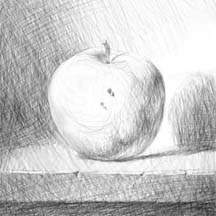
Drawing on paper.
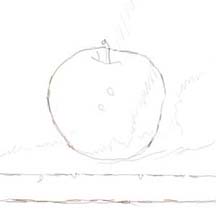
Transferred to the painting.

IMPRIMATURA, or the first paint layer.

The 1 shadow. (2nd paint layer)
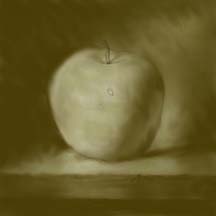
The 2 shadow. (3rd paint layer)
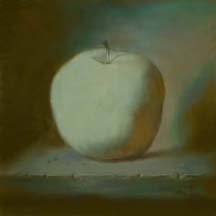
The dead layer. (4th paint layer)

The first body. (5th paint layer)
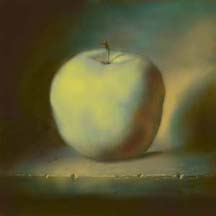
The second body. (6th paint layer)

Details of textures. (7th paint layer)
back
to top
|
